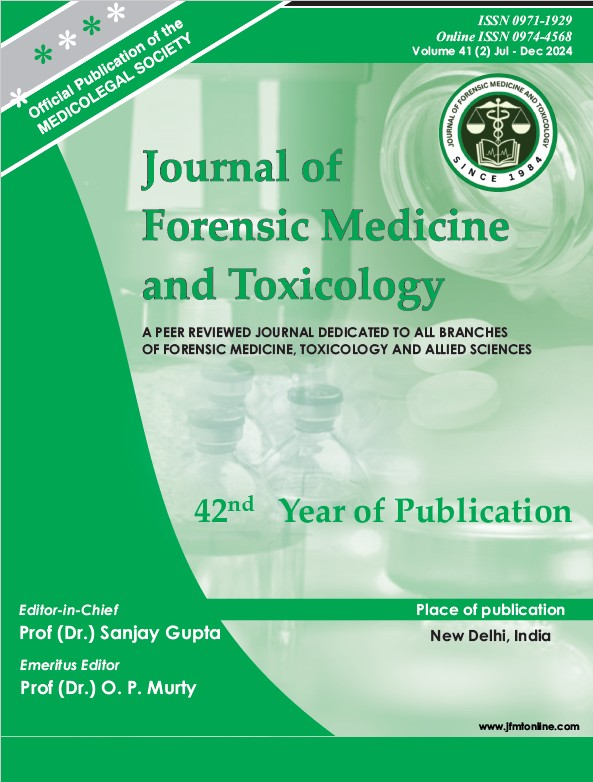Analysis of Motives and Factors Connected to Suicidal Deaths in Bikaner Region of Rajasthan- An Autopsy Based Study.
DOI:
https://doi.org/10.48165/jfmt.2025.42.3.4Keywords:
Suicide, cross sectional study, methods, motive.Abstract
Self-injurious behaviours are amongst the most alarming of all human behaviours and leading cause of death worldwide. The word suicide originated from a latin word Suicidium (to kill oneself). The essential ingredients of suicide include unnatural death with desire from within and reason for ending life. In 2017, Indian Parliament decriminalised suicide. A one-year cross sectional study was conducted from February 2023 to January 2024 in the Department of Forensic Medicine, SPMC, Bikaner. 150 cases with history of suicide subjected to medicolegal autopsy were included in study on a purposive sampling basis. Information was gathered from autopsy related documents, proforma, history of relatives of the deceased, suicide notes, hospital records, concerned investigating agencies and laboratory reports. Number of suicides committed by males were more as compared to females with a ratio of 2:1, maximum in the age group of 21-30 year. Hanging was the most common pattern followed by poisoning. Some cases have previous history of suicide attempt and only few left suicide notes explaining the reason behind their action. Extreme of summer season i.e. months of May, June and July showed more cases and evening time was preferred by most cases. Marital issues were the most common motive behind committing suicide.
Downloads
References
1. Nock, M. K. (Ed.). (2014). The Oxford Handbook of Suicide and Self-Injury. New York: Oxford University Press.
2. Durkheim, É. (1897). Le suicide: Étude de sociologie. Paris: F. Alcan.
3. Saxena, S., Krug, E. G., Chestnov, O., & World Health Organization (Eds.). (2014). Preventing Suicide: A Global Imperative. Geneva: World Health Organization.
4. Lakshmanan, A. R. (2008). Humanization and Decriminalization of Attempt to Suicide. New Delhi: Law Commission of India, Government of India.
5. Kumar, S., Joshi, A., Purohit, R. N., & Acharya, J. (2016). Patterns of suicide among autopsies conducted at Dr. S. N. Medical College, Jodhpur. International Research in Medical and Pharmaceutical Sciences, 2, 33–40.
6. Chavan, B. S., Singh, G. P., Kaur, J., & Kochar, R. (2008). Psychological autopsy of 101 suicide cases from northwest region of India. Indian Journal of Psychiatry, 50(1), 34–38.
7. Jamison, E. C., & Bol, K. A. (2016). Previous suicide attempt and its association with method used in a suicide death. American Journal of Preventive Medicine, 51(5 Suppl 3), S226–S233.
8. Gofii-Sarries, A., Blanco, M., Azcarate, L., Peinado, R., & López-Gofii, J. J. (2018). Are previous suicide attempts a risk factor for completed suicide? Psicothema, 30(1), 33–38.
9. Bhatia, M. S., Verma, S. K., & Murty, O. P. (2006). Suicide notes: Psychological and clinical profile. International Journal of Psychiatry in Medicine, 36(2), 163–170.
10. Namratha, P., Kishor, M., Rao, T. S. S., & Raman, R. (2015). Mysore study: A study of suicide notes. Indian Journal of Psychiatry, 57(4), 379–382.
11. Kulhari, R., Soni, K., Saini, O. P., Saini, P., Buri, S., & Kumar, S. (2018). Pattern of suicidal deaths among females in the reproductive age group of western Rajasthan: An autopsy study. Journal of Punjab Academy of Forensic Medicine and Toxicology, 18(2), 45–48.
12. Vijayakumar, L., Pathere, S., & Jain, S. (2020). Implementation of a comprehensive surveillance system for recording suicides and attempted suicides in rural India. BMJ Open, 10, e034305.
13. Dutta, S., Meena, R. K., Simatwal, N., & Kumar, N. (2020). Patterns of suicides in Jaipur: An autopsy-based study. Indian Journal of Forensic and Community Medicine, 42(2), 123–126.
14. Manoranjitham, S. D., Rajkumar, A. P., Tlhangadurai, P., Prasad, J., Jayakaran, R., & Jacob, K. S. (2010). Risk factors for suicide in rural south India. British Journal of Psychiatry, 196(1), 26–30.




